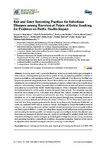Exit and Entry Screening Practices for Infectious Diseases among Travelers at Points of Entry: Looking for Evidence on Public Health Impact
Mouchtouri, Varvara A.
Christoforidou, Eleni P.
an der Heiden, Maria
Menel Lemos, Cinthia
Fanos, Margherita
Rexroth, Ute
Grote, Ulrike
Belfroid, Evelien
Swaan, Corien
Hadjichristodoulou, Christos
A scoping search and a systematic literature review were conducted to give an insight on entry and exit screening referring to travelers at points of entry, by analyzing published evidence on practices, guidelines, and experiences in the past 15 years worldwide. Grey literature, PubMed. and Scopus were searched using specific terms. Most of the available data identified through the systematic literature review concerned entry screening measures at airports. Little evidence is available about entry and exit screening measure implementation and effectiveness at ports and ground crossings. Exit screening was part of the World Health Organisation’s (WHO) temporary recommendations for implementation in certain points of entry, for specific time periods. Exit screening measures for Ebola Virus Disease (EVD) in the three most affected West African countries did not identify any cases and showed zero sensitivity and very low specificity. The percentages of confirmed cases identified out of the total numbers of travelers that passed through entry screening measures in various countries worldwide for Influenza Pandemic (H1N1) and EVD in West Africa were zero or extremely low. Entry screening measures for Severe Acute Respiratory Syndrome (SARS) did not detect any confirmed SARS cases in Australia, Canada, and Singapore. Despite the ineffectiveness of entry and exit screening measures, authors reported several important concomitant positive effects that their impact is difficult to assess, including discouraging travel of ill persons, raising awareness, and educating the traveling public and maintaining operation of flights from/to the affected areas. Exit screening measures in affected areas are important and should be applied jointly with other measures including information strategies, epidemiological investigation, contact tracing, vaccination, and quarantine to achieve a comprehensive outbreak management response. Based on review results, an algorithm about decision-making for entry/exit screening was developed.
Dateien zu dieser Publikation

